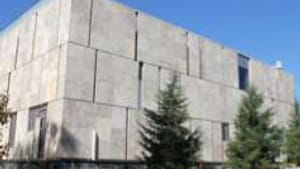Stay in the Loop
BSR publishes on a weekly schedule, with an email newsletter every Wednesday and Thursday morning. There’s no paywall, and subscribing is always free.
First peek at the new Barnes: And the verdict is….
The new Barnes: a sneak preview

We're only moments"“ well, a month"“ away from the opening of the new Barnes on the Parkway. Inside the new walls, the storied collection is being hung, and workers are scrambling to finish the construction and landscaping. Last week I took a preview tour led by Tod Williams and Billie Tsien, the architects for the building. Here's what I saw.
At first glance, the new building is miles away— figuratively as well as literally— from the 1922 Beaux Arts building designed by Paul Cret in Lower Merion. This is not a bad thing.
The new building is clean, elegant, spacious and full of light, with spaces tailored for use by a broader public than ever saw the Barnes Collection in its original home, including an auditorium, library and a lounge with a café. There is a gallery for temporary exhibits and a well-appointed, up-to-date conservation studio.
Through the building's center runs a high, wide, light-filled hall, a dramatic space that both buffers and joins the halves of the building: On one side are the entrance areas and new gallery, on the other the revered collection, intact and carefully preserved in galleries that precisely reproduce the old. The broad central hall opens out to a terrace under a cantilevered overhang, a calm, quiet space that meets the garden surrounding the building while also providing a pleasantly veiled view of the city going about its business.
"'Gallery in a Garden'
The Williams–Tsieh design mantra— "A Gallery in a Garden"— is everywhere you look, in large and small ways. One small garden is inside, set in a light well to enhance lower level spaces where people will relax and congregate; the long section of the garden fronting the Parkway, with a rectangular fountain, will be open to the public.
The building façade is a mosaic of warm, mottled limestone in smooth slabs of varying size, spaced with slits and windows. A frosted glass clerestory crowns the building, softening the roofline against the sky while bringing an abundance of filtered light into the interior spaces.
The same stone— a soft golden color, and almost soft to the touch— is used inside. In the entrance areas it is chipped by hand in a regular/irregular pattern that the architects called "cuneiform," while in the hall it conveys a different texture that quietly bounces the natural light.
Huge mullioned windows with wood frames allow a view into the galleries, a reminiscent feature that visitors to the old Barnes will recognize— although here, for the most part, the windows will remain unshaded.
Protecting the paintings
The building's unseen but essential technical systems are state of the art. The Barnes has been awarded a Leadership in Energy and Environmental Design (LEED) Platinum certification for energy efficiency, the highest rating possible. The collection will benefit from modern technology in several ways, including a system to precisely regulate light to ensure the best conditions for the paintings.
This preview tour didn't allow us into the art galleries themselves, although we did glimpse a few frames and, yes, Albert Barnes's beloved gadgets on the burlap walls. We were assured that the maximum difference in the hanging of any of the works would be an eighth of an inch from the Merion arrangements.
Standing back from the building, I considered how thoughtfully the design balances respect with innovation, inside and out. The façade, with its irregular mosaic pattern, could be a metaphor for Albert Barnes's own philosophy: Here is an overall plan, careful and logical, punctuated by irregularly sized openings to signify personal preferences, artistic choices, various cultural traditions, and a mix of unexpected elements.♦
To read responses, click here.
At first glance, the new building is miles away— figuratively as well as literally— from the 1922 Beaux Arts building designed by Paul Cret in Lower Merion. This is not a bad thing.
The new building is clean, elegant, spacious and full of light, with spaces tailored for use by a broader public than ever saw the Barnes Collection in its original home, including an auditorium, library and a lounge with a café. There is a gallery for temporary exhibits and a well-appointed, up-to-date conservation studio.
Through the building's center runs a high, wide, light-filled hall, a dramatic space that both buffers and joins the halves of the building: On one side are the entrance areas and new gallery, on the other the revered collection, intact and carefully preserved in galleries that precisely reproduce the old. The broad central hall opens out to a terrace under a cantilevered overhang, a calm, quiet space that meets the garden surrounding the building while also providing a pleasantly veiled view of the city going about its business.
"'Gallery in a Garden'
The Williams–Tsieh design mantra— "A Gallery in a Garden"— is everywhere you look, in large and small ways. One small garden is inside, set in a light well to enhance lower level spaces where people will relax and congregate; the long section of the garden fronting the Parkway, with a rectangular fountain, will be open to the public.
The building façade is a mosaic of warm, mottled limestone in smooth slabs of varying size, spaced with slits and windows. A frosted glass clerestory crowns the building, softening the roofline against the sky while bringing an abundance of filtered light into the interior spaces.
The same stone— a soft golden color, and almost soft to the touch— is used inside. In the entrance areas it is chipped by hand in a regular/irregular pattern that the architects called "cuneiform," while in the hall it conveys a different texture that quietly bounces the natural light.
Huge mullioned windows with wood frames allow a view into the galleries, a reminiscent feature that visitors to the old Barnes will recognize— although here, for the most part, the windows will remain unshaded.
Protecting the paintings
The building's unseen but essential technical systems are state of the art. The Barnes has been awarded a Leadership in Energy and Environmental Design (LEED) Platinum certification for energy efficiency, the highest rating possible. The collection will benefit from modern technology in several ways, including a system to precisely regulate light to ensure the best conditions for the paintings.
This preview tour didn't allow us into the art galleries themselves, although we did glimpse a few frames and, yes, Albert Barnes's beloved gadgets on the burlap walls. We were assured that the maximum difference in the hanging of any of the works would be an eighth of an inch from the Merion arrangements.
Standing back from the building, I considered how thoughtfully the design balances respect with innovation, inside and out. The façade, with its irregular mosaic pattern, could be a metaphor for Albert Barnes's own philosophy: Here is an overall plan, careful and logical, punctuated by irregularly sized openings to signify personal preferences, artistic choices, various cultural traditions, and a mix of unexpected elements.♦
To read responses, click here.
What, When, Where
Barnes Foundation. Opening May 19, 2012 at 2025 Benjamin Franklin Parkway. (215) 640-0171 or www.barnesfoundation.org.
Sign up for our newsletter
All of the week's new articles, all in one place. Sign up for the free weekly BSR newsletters, and don't miss a conversation.

 Marilyn MacGregor
Marilyn MacGregor